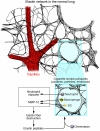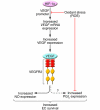Molecular pathogenesis of emphysema
- PMID: 18246188
- PMCID: PMC2214683
- DOI: 10.1172/JCI31811
Molecular pathogenesis of emphysema
Abstract
Emphysema is one manifestation of a group of chronic, obstructive, and frequently progressive destructive lung diseases. Cigarette smoking and air pollution are the main causes of emphysema in humans, and cigarette smoking causes emphysema in rodents. This review examines the concept of a homeostatically active lung structure maintenance program that, when attacked by proteases and oxidants, leads to the loss of alveolar septal cells and airspace enlargement. Inflammatory and noninflammatory mechanisms of disease pathogenesis, as well as the role of the innate and adaptive immune systems, are being explored in genetically altered animals and in exposure models of this disease. These recent scientific advances support a model whereby alveolar destruction resulting from a coalescence of mechanical forces, such as hyperinflation, and more recently recognized cellular and molecular events, including apoptosis, cellular senescence, and failed lung tissue repair, produces the clinically recognized syndrome of emphysema.
Figures




References
-
- Fulton, J.F. 1930. Selected readings in the history of physiology. Charles C. Thomas. Springfield, Illinois, USA. 307–315.
-
- Snider G.L., Kleinerman J., Thurlbeck W.M., Bengali Z.H. The definition of emphysema. Am. Rev. Respir. Dis. 1985;132:182–185. - PubMed
-
- Laennec, R.T. 1819. De auscultation médiate; ou, Traité du diagnostic del maladies des poumons et du coeur. Brosson et Chaude. Paris, France.
-
- Laennec, R.T. 1834. A treatise on the diseases of the chest. Longman. London, United Kingdom.
-
- Filley G.F. Emphysema and chronic bronchitis: clinical manifestations and their physiologic significance. Med. Clin. North Am. 1967;51:283–292. - PubMed
Publication types
MeSH terms
Substances
Grants and funding
LinkOut - more resources
Full Text Sources
Other Literature Sources
Molecular Biology Databases

